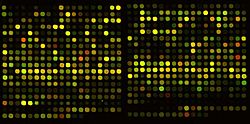This article needs additional citations for verification. (October 2010) |

In genetics, complementary DNA (cDNA) is DNA that was reverse transcribed (via reverse transcriptase) from an RNA (e.g., messenger RNA or microRNA). cDNA exists in both single-stranded and double-stranded forms and in both natural and engineered forms.
In engineered forms, it often is a copy (replicate) of the naturally occurring DNA from any particular organism's natural genome; the organism's own mRNA was naturally transcribed from its DNA, and the cDNA is reverse transcribed from the mRNA, yielding a duplicate of the original DNA. Engineered cDNA is often used to express a specific protein in a cell that does not normally express that protein (i.e., heterologous expression), or to sequence or quantify mRNA molecules using DNA based methods (qPCR, RNA-seq). cDNA that codes for a specific protein can be transferred to a recipient cell for expression as part of recombinant DNA, often bacterial or yeast expression systems.[1] cDNA is also generated to analyze transcriptomic profiles in bulk tissue, single cells, or single nuclei in assays such as microarrays, qPCR, and RNA-seq.
In natural forms, cDNA is produced by retroviruses (such as HIV-1, HIV-2, simian immunodeficiency virus, etc.) and then integrated into the host's genome, where it creates a provirus.[2]
The term cDNA is also used, typically in a bioinformatics context, to refer to an mRNA transcript's sequence, expressed as DNA bases (deoxy-GCAT) rather than RNA bases (GCAU).
Patentability of cDNA was a subject of a 2013 US Supreme Court decision in Association for Molecular Pathology v. Myriad Genetics, Inc. As a compromise, the Court declared, that exons-only cDNA is patent-eligible, whereas isolated sequences of naturally occurring DNA comprising introns are not.
- ^ Hastings, P. J. (1 January 2001), "Complementary DNA (cDNA)", in Brenner, Sydney; Miller, Jefferey H. (eds.), Encyclopedia of Genetics, New York: Academic Press, p. 433, ISBN 978-0-12-227080-2, retrieved 29 November 2022
- ^ Croy, Ron. "Molecular Genetics II - Genetic Engineering Course (Supplementary notes)". Durham University durham.ac.uk; 20 April 1998. Archived from the original on 24 August 2002. Retrieved 4 February 2015.